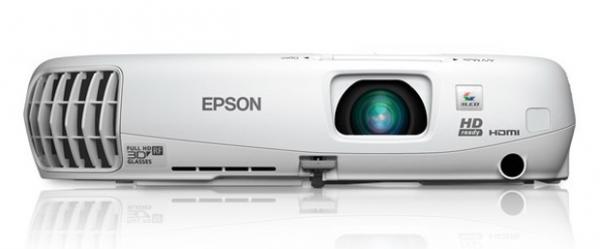Review: Epson PowerLite Home Cinema 750HD

Let’s cut right to it: this projector is staggeringly, amazingly, blindingly bright. It’s brighter than any projector I can remember measuring. It’s brighter than any plasma. It’s brighter than most LCD TVs I’ve reviewed. Uncalibrated, on a 102-inch, 1.0-gain screen, I got 87 footlamberts. That means, with a slightly smaller screen, or a screen with even a little gain, you could have an over 100-footlambert image from a projector Oh, and it’s $800... The unassuming little 750HD has a family resemblance to the excellent 5020 we reviewed a few months back. Its curvy white shell looks nicer than most budget projectors. Resolution is 1,280x800, so either you have black bars with regular HD content, or there’s 40 pixels of “black” spill above and below your screen. Setup is a little more tricky than other LCD projectors I’ve reviewed. For one, there’s no lens shift. Instead, there’s an automatic keystone correction. I can see this being useful for quick setups, but all keystone correction reduces resolution and can potentially add artifacts, so I always advice disabling it. There’s a slight upwards throw, I found I could place the projector roughly level with the bottom of my screen. The zoom range isn’t great, though many inexpensive projectors (especially of the DLP variety) are worse. I could put it behind my sofa to fill my 102-inch screen, which isn’t true with some expensive projectors I’ve reviewed.
Picture options are a little sparse. You have basic adjustments, plus color temp presets, but the only in-depth calibration adjustments are global RGB. This is a little disappointing, as a color management system or multi-step color temp controls would help the image quality. Maybe this is too much to ask of an inexpensive projector, but others in this price range have these features. OK, let’s get to it. This thing is bright. Out of the box, in Dynamic mode, I measured 87 footlamberts. For comparison, the last LED LCD I reviewed had a maximum light output of 100 ftL... from 55-inches. Of course, calibrated to be closer to the D6500 color temperature standard, it was slightly lower. Lower, though 76 ftL is still 26% brighter than the next closest projector. The black level, however, was also quite high. Calling it “black” is a bit of a misnomer, as 0.133 is definitely more a light gray. As a result, the native contrast ratio, 573:1 is really poor. This is one of the lowest I’ve measured in years. The image looks quite washed out, lacking the pseudo-depth found on higher contrast ratio displays. There is an auto-iris that tries valiantly to improve the dynamic contrast ratio, but even that maxes out at 2,917:1. It’s also rather slow and noisy. I ended up leaving it off. (For the difference between native and dynamic contrast ratio, check out Contrast ratio vs black level and Contrast ratio: or how every TV manufacturer lies to you) Color, too, isn’t great. In the more accurate Cinema picture mode, each color point is slightly off the HDTV spec. Not enough that the image looks strange, but it lacks the realism of better color accuracy. In the Dynamic mode, the primary colors are roughly the same, but the secondary colors (cyan, magenta, and yellow) all get slight worse. (Check out the full measurements here.) Not only is the 750HD 3D-capable, it comes with 1 pair of active shutter glasses. Because of the brightness, the 3D was decent, though there was some cross talk. Being 720p (OK, 800p), the image was slightly softer looking than a 1080p projector. I could make out pixels on my 102-inch screen from 9-feet away, so if you’re planning on a larger screen from a similar distance, you will probably see the same. I wasn’t bothered by either of these factors, but resolution tends to be a touchy subject for some, so if resolution is high on your list of things a display must have, well, you probably stopped reading a while ago. It’s also worth noting that the little 750HD is loud. Especially in High Power Consumption mode, but even in Low. For something that, because of its zoom range, is necessarily going to be near your seats, it is quite noticeable. That said, other projectors in this range aren’t exactly quiet, so it’s a matter of degree, I suppose. The BenQ W1070 we reviewed recently is some strong competition. True, the BenQ isn’t as bright (honestly, nothing is), but it’s still very bright. The BenQ is better in most other ways, though. It’s got a better contrast ratio, more accurate color, and much better motion resolution. True, it’s $200 more expensive, but the overall image is better. I suppose it comes down to how you plan on using the projector. If you’re going to setup a theater, and are looking for the best image possible in this price range, I’d go with the BenQ. On the other hand, if you’re looking to create a truly massive image, like using the side of your house for neighborhood movie nights, nothing could create a watchable image as large as the 750HD can. The 750HD does one thing well: O-type-star-like brightness. A true muscle car, with a tremendous engine and mind-altering acceleration. Like a muscle car, though, it doesn’t corner or stop particularly well. The contrast ratio is notably bad, and the color accuracy is fairly mediocre. The BenQ is $200 more, and a much more well-rounded projector. That said, the 750HD offers something literally no other projector does: 75 ftL (or 87, uncalibrated) for $800. So in a way it’s in a class by itself, capable of the largest images you can image. That is, if your house, yard, neighborhood, local galactic cluster, etc has the space to project the image on. (Check out the full pre/post calibration measurements in both Dynamic and Cinema mode here.)

Bottom Line





























































